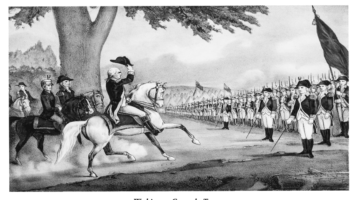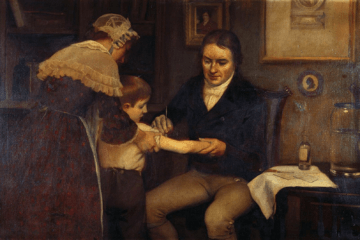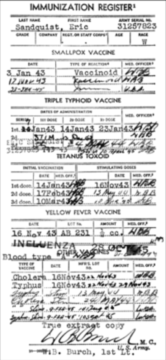by Mark Harvey

Here’s a weird thought: if it weren’t for 18th-century vaccines, America might have lost the revolutionary war to the British. That would have meant that all the anti-vaxxers today touting their freedom not to get a vaccine might have inherited quite a different destiny of eating scones and clotted cream under the British crown. Viruses have always been with us and they always will be, but in the early days of the revolutionary war, an invisible enemy probably killed more American soldiers than the British did. That quiet killer with no generals, no cannon, no forts, and no muskets was smallpox. The weapon against smallpox back then wasn’t truly a vaccine, for modern vaccines hadn’t been invented. But the inoculations were based on a similar principle of introducing a pathogen into a human to develop immunity to a disease.
It’s hard to know exactly how long smallpox has been with us, but we do know that it has been around for at least a few thousand years and probably killed Pharaoh Ramses V in 1157 B.C. When archaeologists unwrapped the linens and layers of resin preserving the pharaoh, his skin showed the characteristic pockmarks of a bad case of smallpox.
George Washington himself had suffered a bout of smallpox when he was traveling with his brother through Barbados at the age of 19. The illness incapacitated him for a solid month but also left him with a lifelong immunity, and a respect and understanding of the disease that would come to play a huge role in the revolutionary war and even the destiny of our country.
It is little known and little taught that in North America there was a smallpox epidemic that occurred in almost the identical years of the revolutionary war from 1775-1883. So while Washington and his generals developed strategies to defeat the British up and down the eastern seaboard, they were also fighting this most deadly virus.

Washington was faced with Smallpox as a second enemy from the outset of the war in 1775 when the Continental Army pinned the British in Boston after the battles of Concord and Lexington. Even as he and his army had trapped part of the British army in Boston, so too American residents of Boston were trapped in the city. When an outbreak of smallpox began to spread wildly in Boston, the Americans began to succumb to the disease and die in much greater numbers than the British for few had been exposed to it and therefore lacked immunity. Because it was a European disease, many of the British soldiers had already developed lifelong immunity.
At the time, none of the carefully developed vaccines we have today had been developed but a sort of crude inoculation was in use throughout Asia, Europe, and parts of the North American continent. The procedure was called variolation, from the virus’s more formal name, variola. In Asia, dried scabs from a person infected with smallpox were ground up into powder and blown into a patient’s nose as a form of inoculation.
In America, around 1721 during a terrible outbreak of smallpox in Boston, the minister Cotton Mather had learned about inoculation from his African slave Onesimus. The procedure that Onesimus taught Mather was to take the pus from a smallpox wound of an infected person, create a small cut on the arm or hand of a healthy person and rub the pus on that person’s wound. The procedure usually caused a mild case of smallpox, but the person soon recovered and then had a lifelong immunity. It was not understood why the intentional infecting of a person was less lethal than the natural spread by aerosols. And the procedure was not without risk as between 2-3% of those variolated died. But smallpox contracted by natural means usually killed about 30% of those it made ill.
Then as now, there was lots of resistance to the inoculations. It was difficult for Mather to find a doctor to perform the procedure, and Mather himself was subjected to threats and violence for trying to make the inoculations a community-wide project. In November of 1721 during the epidemic, an anti-inoculator tossed a homemade bomb through Mather’s window with a note saying, “Cotton Mather, you dog, dam you! I’ll inoculate you with this; with a pox to you.’’ The bomb didn’t explode but Mather’s efforts to inoculate his community were met with derision. Many of the puritans at the time believed that to introduce an infectious agent into the human body, even if it might save that human, went against God’s will. That in effect, if God brought this deathly disease to mortal man, he had his reasons for doing so and to meddle with the disease was to meddle with God’s will.

But Mather persisted. He had seen 9 of his 15 children die before becoming mature adults and had seen three epidemics of smallpox. He finally found a doctor, Zabdiel Boylston, who would administer the inoculations to nearly 300 people. Of the 287 people that were inoculated by Boylston, only 2% died—a mortality rate far lower than those dying in droves in Boston during the same period.
It does strain the imagination to think that a man like Mather, a devout Puritan who believed that certain women in the town of Salem were truly witches casting evil spells on children (and whose executions Mather heartily supported) could at the same time become a leading advocate for a viral treatment that in retrospect has been scientifically validated. In a way, he embodied America’s transition from the very superstitious to the scientific.
So when Washington was given control of the Continental Army in 1775, he immediately faced a most bewitching problem of what to do about Boston. The British and the American revolutionaries were at a stalemate over the town, with the Americans trying to prevent any overland access. With the smallpox outbreak in the city, Washington faced a dilemma: He wanted to attack the British but he knew that attacking the city would risk infecting his soldiers and losing both lives and morale. He also believed that the British were using smallpox and their advantage of inoculation as a sort of biological warfare. On December 14, 1775, he wrote, “….small-pox rages all over the town. Some of the [British] military as had it not before, are now under inoculation. This, I apprehend, is a weapon of defense they are using against us.” The next day he wrote, “…smallpox is in every part of Boston. The [British] soldiers who have never had it are, we are told, under inoculation, and considered as a surety against any attempt of ours to attack.”
Washington wanted to inoculate his army but knew that doing so would temporarily weaken them as inoculations caused a mild case of smallpox for about a month. He worried that if the British knew of the temporary weakness among his troops that they would take advantage with attacks. He also worried that newly inoculated troops, if not quarantined properly, would lead to contagions of the full-blown disease.
Finally, after less than two years as general of the Continental Army, Washington decided to begin mass inoculations. In a February 6, 1777 letter to Dr. William Shippen, Director of Hospitals for the Continental Army, he wrote, “Finding the Small pox to be spreading much and fearing that no precaution can prevent it from running through the whole of our Army, I have determined that the troops shall be inoculated. This Expedient may be attended with some inconveniences and some disadvantages, but yet I trust in its consequences will have the most happy effects. Necessity not only authorizes but seems to require the measure, for should the disorder infect the Army in the natural way and rage with its usual virulence we should have more to dread from it than from the Sword of the Enemy.”
And so began the first mass inoculations in America, less than a year after the Declaration of Independence was signed. There was no wavering in Washington’s orders, no room for interpretation of what the order meant. In the same letter to Dr. Shippen, he wrote “I request that you will without delay inoculate All the Continental Troops that are in Philadelphia and those that shall come in as fast as they arrive. You will spare no pains to carry them through the disorder with the utmost expedition, and to have them cleansed from the infection when recovered, that they may proceed to Camp with as little injury as possible to the Country through which they pass. If the business is immediately begun and favoured with the common success, I would fain hope they will be soon fit for duty, and that in a short space of time we shall have an Army not subject to this the greatest of all calamities that can befall it when taken in the natural way.”
Washington’s war for the next three years was fought on two fronts: the redcoats and smallpox. In many ways, the British were far less formidable than the variola. For one thing, an army of hundreds or thousands of men in red coats marching to the fife and drum, no matter how clever their strategy, are not hard to track. Variola major, by contrast,is about 200 nanometers in diameter, 250 nanometers long, and 250 nanometers high: several thousand times smaller than the diameter of human hair. The British required food, clothing, munitions, and evidently lots of port wine. They were often distracted by colonial pub life and awaited orders from King George to make big moves. The variola virus traveled silently and invisibly, and only needed warm bodies to replicate and a cough or sneeze to motivate. John Adams, the second president of the United States called smallpox “ten times more dangerous than Britons, Canadians and Indians together.”
In early 1777, the Continental Army hospitals began inoculations in New York, New Jersey, Connecticut, Pennsylvania, Rhode Island, and Virginia. Washington ordered the inoculations to be done with total secrecy as he knew that the temporary weakened state of thousands of his soldiers might encourage British attacks. Even as thousands of men were inoculated, Washington was impatient with the progress and complained to his generals about soldiers not being inoculated faster.
By late 1778, Washington had largely gained control of smallpox in his army through quarantines and inoculations. His unremitting efforts to inoculate the army had two advantageous effects in the fight against the British: it allowed him to fight with a much healthier body of troops where he wanted, when he wanted and with less fear of the virus; and it made recruiting soldiers much easier as during the large outbreaks many men refused to join the volunteer army for fear of being infected.

Washington’s orders to inoculate his men began a 250-year history of inoculations and then modern vaccines–when they were invented–that continue today in the armed forces. Depending on their deployment and the times, US service members have been required to be vaccinated for typhoid, diphtheria, yellow fever, polio, tetanus, hepatitis B, hepatitis A, and sundry others. Today, depending on where they are stationed, American soldiers can be required to receive as many as 17 vaccinations. Next month, US soldiers will be required to get a vaccine for COVID 19. Army General Mark Milley, chairman of the Joint Chiefs of Staff, recently wrote “Getting vaccinated against COVID-19 is a key force protection and readiness issue.” Milley’s comments have none of the eloquence or flourishes of Washington’s letters, but his belief in vaccinations as a key to US defense is identical.
Much is written about Washington, but perhaps because of his reserve he is still somewhat of a mystery. By most accounts what he loved most was farming, and he hated leaving his fields and orchards in Mount Vernon. He only took generalship of the Continental Army out of a sense of duty and because his fellow colonists insisted. But there’s little doubt that he had a superior sense of strategy, iron-clad discipline, and a quality of leadership that moved his contemporaries. Those qualities allowed him to outwit and outfight both the British and the variola.
It’s not a comforting thought that the so-called father of our country probably managed viral diseases better than our recent leaders even before he and his countrymen really knew what a virus was. It’s not a comforting thought to think that in the ensuing years since the siege of Boston in 1775 when we’ve developed real vaccines with tested efficacy, when we can actually see viruses with electron microscopes when we can edit and splice genes and have devoted billions of dollars to epidemiology, that today with the Covid virus we still see the same patterns of superstitious behavior and gullibility in modern Americans experienced by Cotton Mather when he set out to inoculate Boston in 1721. The spirit of the witch trials is still with us.
